Accrington Corporation Steam Tramways
History
Accrington Corporation acquired powers to build a 5.7-mile tramway system on the 12th July 1882, under the Accrington Corporation Tramways Act, 1882.
Construction of the 4ft 0ins-gauge steam tramway did not start until 1884, and was plagued by problems from the outset, with allegations of corruption in the choice of the contractor, who then ran out of money, all ending in the corporation having to complete the system itself, for which it appears to have lacked the requisite skills. The track was not only badly laid, but was also of a design — the Barker rail — that was to prove itself fundamentally unsuited to the use of steam tram engines. As municipal authorities were prevented from operating tramways by the Tramways Act of 1870, this was to have serious consequences for the eventual lessee (operator).
After struggling to find a lessee, an agreement was finally signed on the 29th October 1885, with Messrs Cash and Company of London, who then set up a new company — the Accrington Corporation Steam Tramways Company — to operate the tramway; the ACSTCo was incorporated on the 12th December 1885.
Public steam services commenced on the 8th April 1886 between Church, Accrington Market Place and Clayton-le-Moors, the rest of the system, between Accrington Market Place and Baxenden, opening two months later on the 12th June 1886. As the enabling act only allowed two years for construction from the date of Royal Assent, some kind of dispensation must have been sought to extend the time allowed.
Despite holding these powers for nearly two years, the corporation was still not ready to take over operation of the system when the lease expired (12th April 1907), so the ACSTCo agreed to continue working the steam services within Accrington until such time as the corporation was ready.
The services were operated under a 21-year lease that commenced on the 5th April 1886, and which was set to expire on the 12th April 1907.
Meanwhile, the company had already given thought to extending the system beyond Accrington, through Haslingden to Rawtenstall, obtaining powers to this end, as well as to reconstruct itself, on the 5th July 1887 under the Accrington Corporation Steam Tramways (Haslingden and Rawtenstall Extension) Act, 1887. Although some histories state that the tracks within Haslingden and Rawtenstall were owned by the respective corporations, later arbitration documents make it very clear that the company was the owner.
The line from the Accrington boundary at Baxenden through to the Commercial Hotel in Haslingden was opened on the 27th August 1887, and from there through Lockgate (the boundary between Haslingden and Rawtenstall) to Queens Square in Rawtenstall in November 1887. This took the ACSTCo-operated steam tramway to its final size of 9.56 miles, 5.5 miles of which was leased from Accrington Corporation. From Accrington Market Place, lines ran: westwards along Blackburn Road to a terminus outside the Commercial Hotel in Church; northwards along Whalley Road to a terminus outside the Load of Mischief Inn in Clayton-le-Moors, which was around 300 yards short of the authorised length; and southeastwards along Manchester Road and Blackburn Road to Haslingden, then eastwards along Haslingden Road through Lockgate, to a terminus at Queens Square in Rawtenstall. Although the system was eventually connected to two other 4ft 0in-gauge steam tramways — at Church (Blackburn Corporation Tramways) and Rawtenstall (the Rossendale Valley Tramway Company) — other than the odd special working, no regular through running took place.
Unfortunately for the ACSTCo (and its shareholders), the Accrington lease included responsibility for the track, which was to cause serious problems for the company, which not only had to spend significant sums as the track rapidly deteriorated, but had also to deal with the deleterious effect on its engines. The expense incurred in dealing with the rail problem, as well as severe downturns in the cotton trade and an unenviable accident record, led to low or no dividends for the best part of a decade. The company's own lines were laid with much more robust girder rails, so did not give rise to the same issues.
By 1892, the ACSTCo was operating its services using 16 steam trams and 17 trailers.
The tramway did eventually pay its way, and by 1899 it had attracted the attention of the British Electric Traction Company. At this time, the BETCo was aggressively purchasing horse and steam-operated tramways across the British Isles with the intention of converting them to electric traction, as well as promoting schemes for completely new electric tramways. Although agreement on the terms of a sale was reached, BETCo interest waned when it became clear that Accrington Corporation was set upon converting its lines to electric traction and operating them itself.
Although the company tried to sell the tramway (the goodwill, engines and trailers, etc.) to Accrington Corporation, the latter chose to wait until the lease expired — in April 1907 — no doubt to ensure that they got the best deal possible. The down side of this was that conversion to electric traction came rather late in the day compared with nearby Blackburn and Darwen, though Haslingden and Rawtenstall were later still, the latter becoming the last street tramway system in Britain to use steam traction on a regular basis.
Despite planning well ahead, Accrington Corporation were, however, not ready to take over operation of the system when the lease expired, so the ACSTCo continued to work the steam services until agreement could be reached. Accrington formally purchased the engines, trailers and assets necessary to work its lines on the 20th September 1907, with the ACSTCo agreeing to continue working the steam services until the end of the year under a contract arrangement. Long before a price was finally agreed, Accrington set about converting its tracks to overhead electric traction, the first electric service running on the 2nd August 1907.
The last steam tram in Accrington duly ran on the 31st December 1907, electric services to Baxenden (on the Accrington-Haslingden boundary) commencing the following day. On the same day (the 1st January 1908), Haslingden and Rawtenstall Corporations took over the former ACSTCo lines within their respective boroughs, as well as an agreed proportion of the ACSTCo's engines and trailers, with Haslingden Corporation providing the services for both corporations thereafter.
Uniform
Like many other steam-operated tramway systems, steam tram drivers wore railway footplate-like attire comprising cotton jackets and trousers, along with a grease-topped or soft-topped caps; no badges or insignia were worn. The situation with respect to conductors is unclear, surviving photographs often containing seemingly contradictory information, though this may be more due to problems dating them than anything else.
The earliest images suggest that conductors wore informal jackets, along with what were probably kepi-style caps. The latter appear to have borne a metal cap badge, possibly a block-lettering grade badge, 'CONDUCTOR'. In later years, conductors were provided with single-breasted uniform jackets with stand-up collars, and kepi-style caps; it is unclear what insignia either of these bore.
Two photographs have survived of what would appear to be senior staff. The earliest of these show a gentleman wearing a three-quarter length, double-breasted overcoat with lapels and four pairs of buttons (plain), but no badges. Headwear was a kepi-style cap that bore a one-piece, block-lettering grade badge 'INSPECTOR'. The attribution of this photograph remains, however, uncertain, and it entirely possible that the individual depicted was not an ASCTCo inspector. The second image, which again cannot be dated accurately, is thought to have been taken right at the end of company operation, and shows a man who is very probably an inspector; he is wearing a single-breasted jacket with stand-up collars, along with a drooping-peak cap, the latter bearing a large oval cap badge, probably of embroidered cloth.
Further reading
For more information on the system, see: 'The Tramways of Accrington 1886-1932' by R W Rush; The Light Railway Transport League (1961).
Images
Steam tram drivers and conductors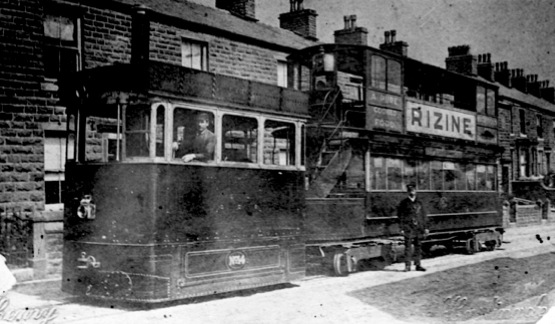
Steam Tram No 14 and an unidentified trailer pictured on what is probably Blackburn Road in Haslingden — photo undated, but certainly taken between 1887 and 1890 given that the Ashburys trailer has open upper-deck sides (thanks to Phil Calvey for this information). Photo courtesy of the Tramways and Light Railway Society, with thanks to David Voice.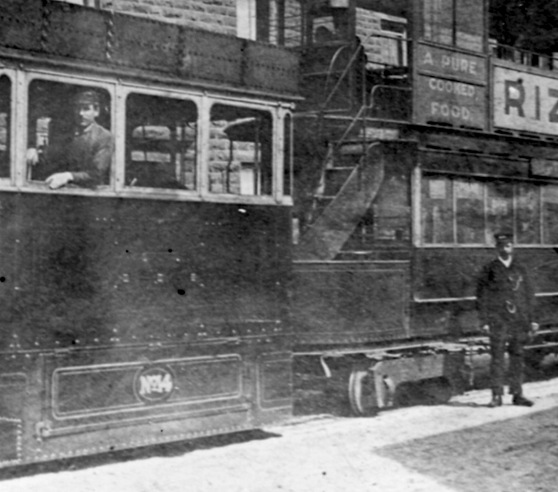
An enlargement of the above photograph showing the engine driver and the conductor; the latter appears to be wearing an informal jacket along with a cap, possibly a kepi.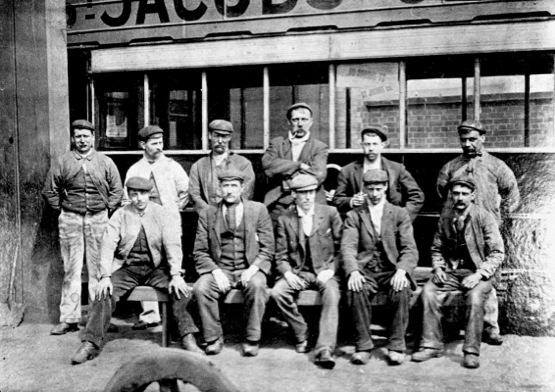
A depot shot taken some time after 1899, when the trailer behind was acquired (thanks to Phil Calvey for this information). The men pictured are probably a mixture of fitters and drivers. Photograph courtesy of Duncan Holden.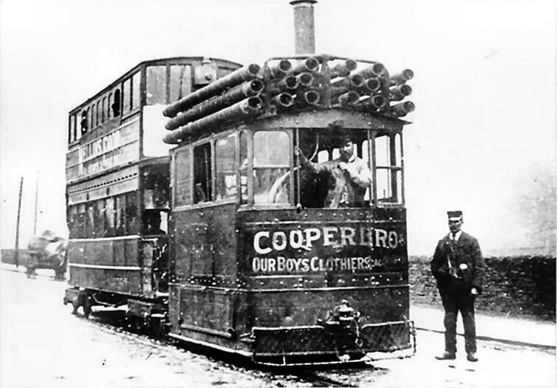
Steam Tram No 6, which was delivered in 1898, captured together with its trailer at an unknown location— photo undated, but probably taken in 1907 given that there appears to be an electric traction pole in the background. The conductor is wearing a kepi-style cap and what would appear to be an informal jacket. Photo courtesy of Duncan Holden.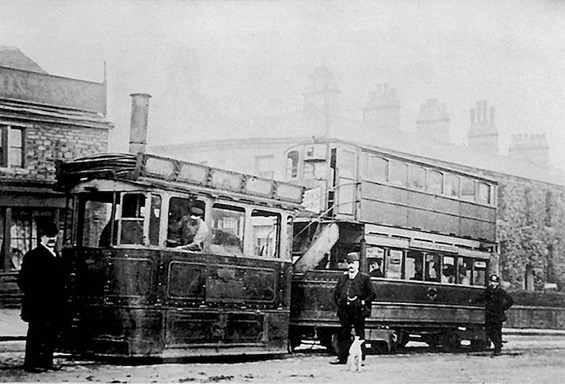
A photograph taken outside The Park public house in Manchester Road between Accrington and Baxenden, purportedly on the 4th September 1908, showing the 'last steam tram in Manchester Rd'. On the face of it, however, this would seem to be fairly unlikely, given that this portion of the route had been converted to electric traction some eight months beforehand, and there are no signs whatsoever of overhead electric wires or traction poles. It therefore seems likely that the dating is wrong, and that it was in fact taken prior to electrification. Photo courtesy of David Gladwin, with thanks to Trevor Preece.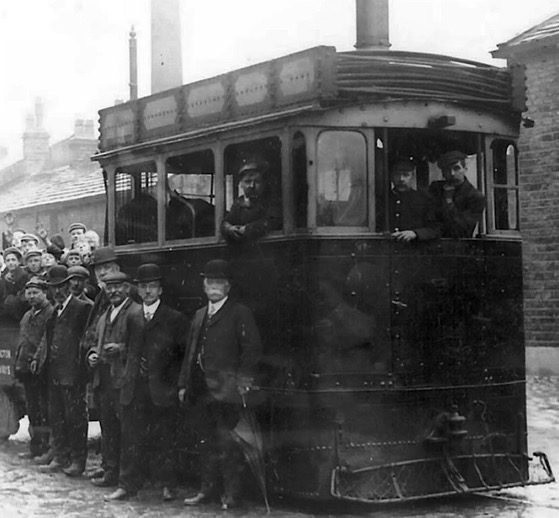
An unidentified steam tram, with an Accrington Corporation Tramways trailer, engaged in finishing work on the new electric route to Oswaldtwistle (note the electric traction pole in the background), dating the photograph to 1907. The figure with arms folded in the cab is almost certainly the driver, whilst the man on the right may be a stoker. It is unclear who the figure is in the cab wearing what appears to be a uniform jacket and a flat cap. Photograph courtesy of Duncan Holden.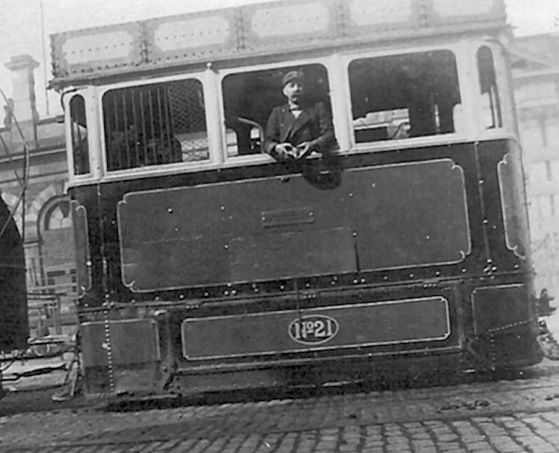
A rather jauntily angled shot of Steam Tram No 21 (ex Blackburn Corporation Tramways Ltd, and still in that company's livery) in Peel Street, Accrington — photo undated, but certainly 20th Century given that No 21 was only acquired in 1901. The figure in the cab would appear to be wearing an unbuttoned lancer-style jacket of the type worn by Accrington Corporation Tramways electric tramcar crews. Photograph courtesy of Duncan Holden.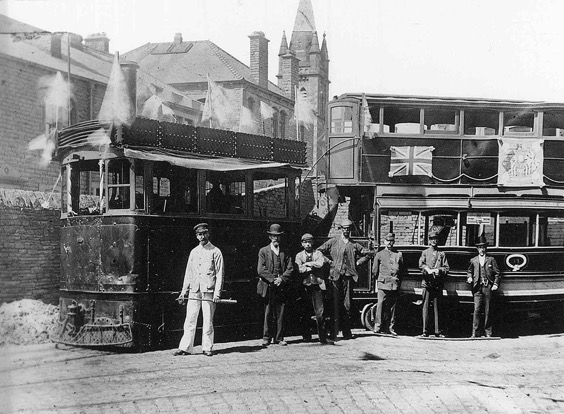
A number of employees and officials stand with a rather care-worn Thomas Green & Sons' steam tram and a Milnes trailer (No 13) in the depot yard at John Street, Haslingden. Although the photograph is undated, the fact that the trailer is decorated, and the driver is wearing what would appear to be brand-new overalls, indicates that it was a special occasion. The most likely candidates are the Diamond Jubilee of Queen Victoria (22nd June 1897), the Coronation of King Edward VII (9th August 1902) or the first day of operation by Haslingden Corporation Tramways (1st January 1908). Whichever it is, the smartly turned out staff are probably wearing uniforms provided by the ASTCo, as in later photographs (of Haslingden Corporation Tramways), all tramcar staff are wearing informal attire (see link). My thanks go to Phil Calvey and Richard Hargreaves for the background information. Photo courtesy of David Gladwin, with thanks to Trevor Preece.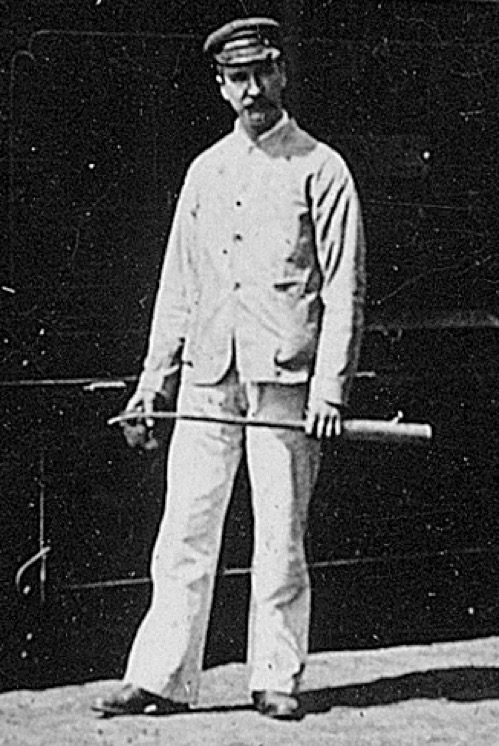
An enlargement of the above photograph showing the driver, who is wearing what appears to be a brand-new, light-coloured cotton jacket, trousers and soft-topped cap. The whole ensemble appears to be devoid of insignia.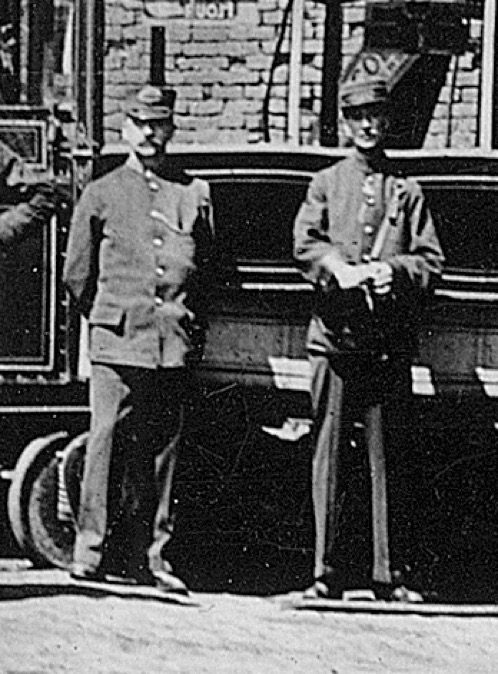
Another enlargement of the above photograph, this time showing two uniformed individuals, possibly an inspector (on the left) and a conductor (on the right.) Both men are wearing single-breasted jackets with a single slit breast pocket, waist-level pockets (with flaps) and stand-up collars, along with kepi-style caps. The inspector's cap clearly bears a large oval cap badge, probably embroidered.
Senior staff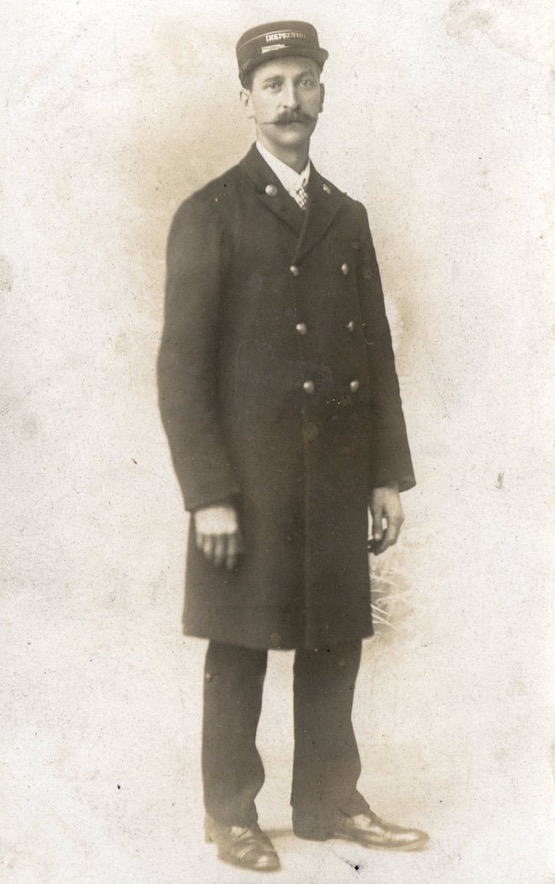
A studio portrait of an individual who may possibly be an ACSTCo inspector. The reverse of the postcard is marked: ''J W Tattersall & Co. Blackburn Rd. Accrington", a photographer who is known to have been active during the last two decades of the 19th Century and the first decade of the 20th. Assuming that the subject was from Accrington, then the only other likely employer of a uniformed inspector, other than the municipal authority, would be the Lancashire and Yorkshire Railway. That company's uniforms and badges are, however, reasonably well attested, so it seems a distinct possibility that the local steam tramway is the correct attribution. Author's Collection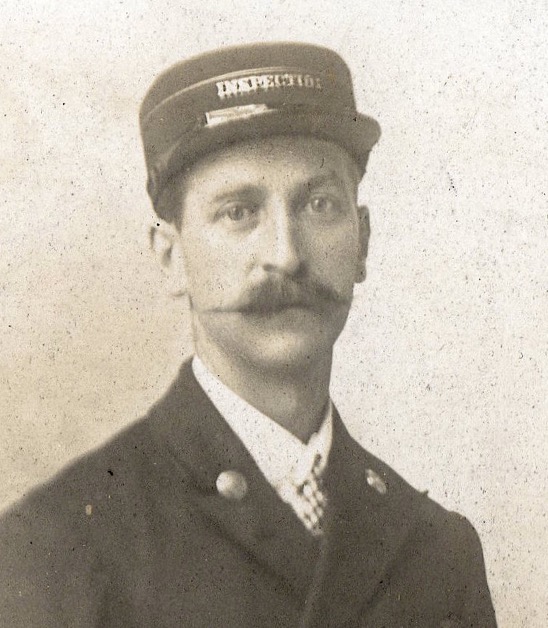
An enlargement of the above photograph showing details of the cap and cap badge. Magnification suggests that the buttons were plain.